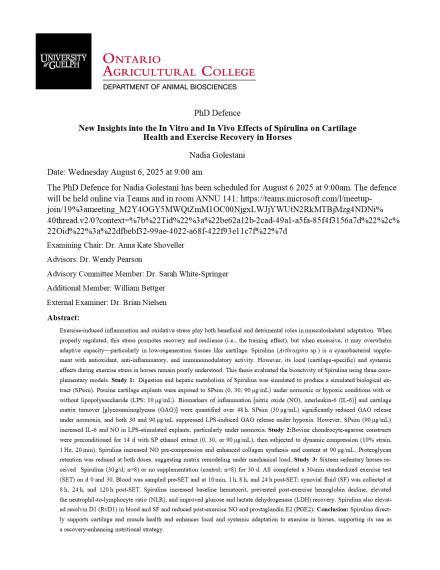Nadia Golestani's PhD Defence
Date and Time
Location
The defence will be held online via Teams and in room ANNU 141: https://teams.microsoft.com/l/meetup-join/19%3ameeting_M2Y4OGY5MWQtZmM1OC00NjgxLWJjYWUtN2RkMTBjMzg4NDNi%40thread.v2/0?context=%7b%22Tid%22%3a%22be62a12b-2cad-49a1-a5fa-85f4f3156a7d%22%2c%22Oid%22%3a%22dfbebf32-99ae-4022-a68f-422f93e11c7f%22%7d

Details
New Insights into the In Vitro and In Vivo Effects of Spirulina on Cartilage Health and Exercise Recovery in Horses
Exercise-induced inflammation and oxidative stress play both beneficial and detrimental roles in musculoskeletal adaptation. When properly regulated, this stress promotes recovery and resilience (i.e., the training effect), but when excessive, it may overwhelm adaptive capacity—particularly in low-regeneration tissues like cartilage. Spirulina (Arthrospira sp.) is a cyanobacterial supplement with antioxidant, anti-inflammatory, and immunomodulatory activity. However, its local (cartilage-specific) and systemic effects during exercise stress in horses remain poorly understood. This thesis evaluated the bioactivity of Spirulina using three complementary models. Study 1: Digestion and hepatic metabolism of Spirulina was simulated to produce a simulated biological extract (SPsim). Porcine cartilage explants were exposed to SPsim (0, 30, 90 µg/mL) under normoxic or hypoxic conditions with or without lipopolysaccharide (LPS; 10 µg/mL). Biomarkers of inflammation [nitric oxide (NO), interleukin-6 (IL-6)] and cartilage matrix turnover [glycosaminoglycans (GAG)] were quantified over 48 h. SPsim (30 µg/mL) significantly reduced GAG release under normoxia, and both 30 and 90 µg/mL suppressed LPS-induced GAG release under hypoxia. However, SPsim (90 µg/mL) increased IL-6 and NO in LPS-stimulated explants, particularly under normoxia. Study 2:Bovine chondrocyte-agarose constructs were preconditioned for 14 d with SP ethanol extract (0, 30, or 90 µg/mL), then subjected to dynamic compression (10% strain, 1 Hz, 20 min). Spirulina increased NO pre-compression and enhanced collagen synthesis and content at 90 µg/mL. Proteoglycan retention was reduced at both doses, suggesting matrix remodeling under mechanical load. Study 3: Sixteen sedentary horses received Spirulina (30 g/d; n=8) or no supplementation (control; n=8) for 30 d. All completed a 30-min standardized exercise test (SET) on d 0 and 30. Blood was sampled pre-SET and at 10 min, 1 h, 8 h, and 24 h post-SET; synovial fluid (SF) was collected at 8 h, 24 h, and 120 h post-SET. Spirulina increased baseline hematocrit, prevented post-exercise hemoglobin decline, elevated the neutrophil-to-lymphocyte ratio (NLR), and improved glucose and lactate dehydrogenase (LDH) recovery. Spirulina also elevated resolvin D1 (RvD1) in blood and SF and reduced post-exercise NO and prostaglandin E2 (PGE2). Conclusion: Spirulina directly supports cartilage and muscle health and enhances local and systemic adaptation to exercise in horses, supporting its use as a recovery-enhancing nutritional strategy.